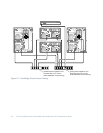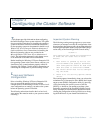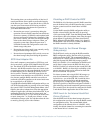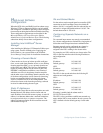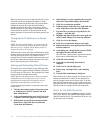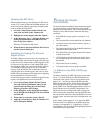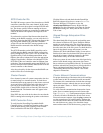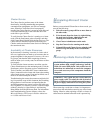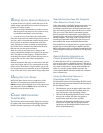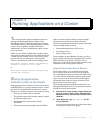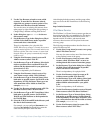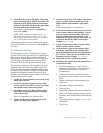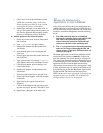
3-8 Dell PowerEdge Cluster (PowerEdge 4200) Installation and Troubleshooting Guide
S
etting Up the Quorum Resource
A quorum resource is typically a hard-disk drive in the
shared storage subsystem that serves the following two
purposes in a cluster system:
•
Acts as an arbiter between the two nodes to ensure
that the specific data necessary for system recovery
is maintained consistently across the nodes
•
Logs the recovery data sent by the cluster nodes
Only one cluster node can control the quorum resource at
one time, and it is that node that remains running when
the two nodes are unable to communicate with each
other. Once the two nodes are unable to communicate,
the Cluster Service automatically shuts down the node
that does not own the quorum resource.
With one of the cluster nodes down, changes to the
cluster configuration database are logged to the quorum
disk. The purpose of this logging is to ensure that the
node that gains control of the quorum disk has access to
an up-to-date version of the cluster configuration
database.
Because the quorum disk plays a crucial role in the oper-
ation of the cluster, the loss of a quorum disk causes the
failure of the Cluster Server. To prevent this type of fail-
ure, the quorum resource should be set up on a redundant
array of hard-disk drives in the shared storage subsystem.
U
sing the
ftdisk
Driver
Microsoft Cluster Server does not support use of the
Windows NT software-based, fault-tolerance driver
ftdisk with any of the hard-disk drives in the shared stor-
age subsystem. However, ftdisk can be used with the
internal drives of the cluster nodes.
C
luster RAID Controller
Functionality
The following subsections describe functional variances
of standard and cluster-enabled PowerEdge Expandable
RAID Controllers operating in a PowerEdge Cluster.
Rebuild Function Does Not Complete
After Reboot or Power Loss
If the cluster node is rebooted or power to the node is lost
while a PowerEdge Expandable RAID Controller is
rebuilding a hard-disk drive, the RAID controller termi-
nates the rebuild operation and marks the drive as failed.
This also occurs if the rebuild is performed from the
RAID controller basic input/output system (BIOS) con-
figuration utility and the user exits the utility before the
rebuild completes. This occurs with all versions of the
PowerEdge Expandable RAID Controller firmware on
both standard and cluster-enabled RAID controllers.
If the rebuild fails to complete due to a system restart, the
rebuild must be reinitiated using the RAID Controller
BIOS configuration utility or using the PowerEdge RAID
Console program running in the Windows NT operating
system.
Rebuild Rate Not Adjustable on
Cluster-Enabled RAID Controller
If a hard-disk drive fails in a redundant array, you can
recover the lost data by rebuilding the drive. The rate of
data reconstruction is called the rebuild rate. The rebuild
rate cannot be adjusted in a cluster-enabled RAID con-
troller as it can in a standard RAID controller. The
cluster-enabled RAID controller rebuilds drive informa-
tion at a default rate.
Using the Maximize Feature in
PowerEdge RAID Console
The Maximize feature of the PowerEdge RAID Console
has the following functional limitations when running in
the PowerEdge Cluster:
•
The Maximize icon at the upper right corner of the
PowerEdge RAID Console is disabled when you
open the program in the PowerEdge Cluster.
•
Whenever the PowerEdge RAID Console is mini-
mized to the task bar, the right-click option to
maximize the application is not available.
•
Whenever the PowerEdge RAID Console is mini-
mized to the task bar and you minimize another
application, the PowerEdge RAID Console maxi-
mizes itself automatically.



